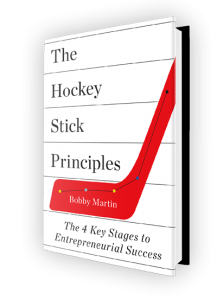The Hockey Stick Principles
Chapter 1
Hitting the Ice: Beginning to Develop Your Idea
When you have an idea for a new product or service, even if you believe it’s a really good one, you can worry that you might be pulling a Kramer, Jerry Seinfeld’s loveable but wacky neighbor, who was always cooking up product and business ideas for his company, Kramerica Industries. Who can for-get the mansiere (a bra for men), the coffee-table book about coffee tables, the roll-out tie dispenser, and the periscope for cars that would allow drivers to see better in urban traffic? Unfortunately, he had little success with any of his ideas, but that’s not because they were all just wacky. One of them was to introduce rickshaws to the streets of Manhattan, which became a booming business not in New York but in dozens of other cities across the United States. Kramer’s problem was that he never buckled down and wrestled with the realities of actually building a company. That is the only way to find out whether your idea will work, no matter how good the idea seems to be.
I believe that one of the most pernicious misconceptions about entrepreneurship is that the best way to go about it is to come up with a truly great idea and then right away build a slam-dunk business model and write a detailed business plan for executing it. This seems to make great sense, but there are many problems with this notion. Probably the biggest is that while some successful entrepreneurs do hit on their ideas in a eureka moment, most often ideas emerge over time, and most of them need a good deal of tinkering with.
Many hugely successful entrepreneurs started with ideas that were deeply flawed in their original iteration. If you are convinced that your idea has to strike everyone you discuss it with as brilliant and has to readily generate a good model that answers all the tough questions about market size, cost, pricing, profit potential, and competition, you are likely to give up on an idea that may well eventually be made to work.
Good Ideas Don’t Grow on Trees
I loved an article in Business Insider titled “This Man Turned Three Bad Ideas into Fortune 500 Companies,” in which the CEO of Gallup, Jim Clifton, is quoted saying that his favorite entrepreneur is billionaire and former Miami Dolphins owner Wayne Huizenga. He points out that Huizenga’s three highly profitable start-ups: Waste Management (the trash business), Blockbuster Video (video rental business), and Auto Nation, Inc. (a chain of used car dealerships) were arguably bad ideas. Clifton did much of the re-search for Huizenga on Blockbuster, and after his research, he didn’t think it was a good idea.10
So why did Huizenga succeed in each case? (Blockbuster was a huge success until Netflix came along and ate its lunch, a danger we’ll dis-cuss later in the book.) Clifton credits his success to “extreme optimism, his unstoppable determination, and his incredible energy.” The most basic reason, though, is that Huizenga figured out how to tweak, build upon, and develop his initial kernels of an idea into good ones over time.
Clifton also researched Ted Turner’s Cable News Network’s twenty-four-hours news idea and concluded it wasn’t a good idea, either. He wrote, “No one wanted more news, and the news Ted was going to show was just a reel of reports played over and over again.” He concluded, “Twenty-four-hour news is a mediocre idea.” Of course, Turner went on to turn it into a fortune.
Tesla’s electric car is a more recent example of an idea that plenty of analysts predicted would be bad but has turned out to be a big success. In 2003, entrepreneur Elon Musk invested $6.35 million in the business despite the fact that the big automakers were backing away from electric cars then because they were proving to be unprofitable. For years, Tesla looked like a bad idea. In 2009, it lost $55.9 million with only $111.9 million revenue, proving the big automakers were correct. So what does Elon Musk do? He invests $75 million more to keep it afloat. By 2014, Tesla had revenues just north of $3.2 billion.
Start-up success is predicated not so much on the idea as on the development of the idea, as well as the tenacity and will to succeed. This is why the common approach of starting by writing a detailed business plan, unless its written for the benefit of investors to better understand your basic plans, is so flawed. Even the best researched plan is only hypothetical; it’s really just the addition of more ideas to your main idea. I’ve seen so many founders think of the plans they’ve written to get started as arguments for their concept, almost as if they are a proof of concept. In no way is that true.
